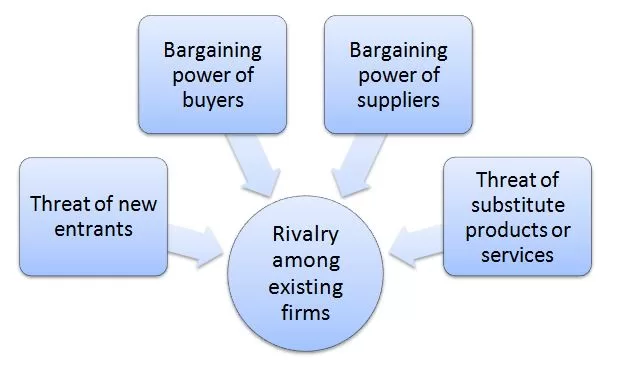
Porter’s Five Forces analytical framework developed by Michael Porter (1979)[1] represents five individual forces that shape an overall extent of competition in the industry. These forces are illustrated in Figure 1 below: Figure 1. Porter’s Five Forces Threat of new entrants in Netflix Porter’s Five Forces Threat of new entrants into the on-demand media streaming is low. Setting up a video steaming website is not difficult from a technical point of view. However, adding an adequate amount of content with the permission of copyright holders and gaining market share is highly difficult. The following are the most noteworthy challenges for new market entrants. Market saturation The market of on-demand media streaming is highly saturated with the streaming giants such as Netflix, Amazon Prime Video, Disney+, Hulu, Apple TV+, HBO Max and others dominating the global market. The majority of representatives of the target customer segment i.e. people with phones, tablets or TVs with internet connection are already subscribed to one or more of the leading streaming services mentioned above. It will be challenging for new market entrants to attract enough subscribers to make a break-even in this sector High entry costs Major market players such as Netflix focus on original content in general and its quality in particular to differentiate themselves in the market. As illustrated in Figure 4 below, the titles of original content produced by the largest streaming service in the world, as well as the hours watched by its customers have been consistently increasing for the past 10 years with the exception of a decline in 2021. Figure 2 Netflix original content by years of transmission[2] Netflix original content spending exceeded USD 5,8 billion in 2022[3] and its main competitors also spend billions of dollars annually for creating new films and programs. Accordingly, the…

Netflix marketing communication mix comprises communication channels to communicate the marketing message to the target customer segment. These channels are print and media advertising, sales promotions, events and experiences, public relations and direct marketing. Netflix Print and Media Advertising Netflix uses print and media advertising extensively as one of the main pillars of its marketing strategy. Specifically, the streaming service uses TV, radio, magazines, newspapers, as well as, billboards and posters to spread its marketing message. Netflix print and media ads are usually captivating and some of them are widely discussed in the media in general and social media in particular expanding the brand coverage with no extra cost for the streaming service. For example, to promote its Altered Carbon series in 2018, the streaming service placed a naked mannequin that appeared to be breathing at the bus stop on Santa Monica Boulevard in Crescent Heights in West Hollywood. The on-demand media provider also benefits from celebrity endorsement in terms of increasing the level of brand awareness internationally. The most famous Netflix endorses include Barack Obama and Michelle Obama, Ryan Reynolds, Jennifer Aniston, Reese Witherspoon, Shonda Rhimes and others. Netflix Sales Promotions Netflix uses the following sales promotion techniques: – Money off coupons. The entertainment services provider partners with a variety of companies to provide special promotional offers. Customers can redeem promo codes on Netflix website and start using its services for a specific period of time – Seasonal sales promotions. The streaming service regularly offers promotions on festive seasons and holidays such as Black Friday, Cyber Monday, Valentine’s Day, Mother’s Day and Father’s Day. Netflix Inc. Report contains a full analysis of Netflix marketing communication mix and Netflix marketing strategy in general. The report illustrates the application of the major analytical strategic frameworks in business studies such as SWOT,…

Netflix segmentation, targeting and positioning efforts are the basis of marketing strategy. Segmentation implies dividing the market into different groups on the basis of common traits and characteristics. The entertainment services provider segments its market on the basis of location, demography, behaviour, psychographic and other variables. Netflix uses the following positioning techniques: 1. Anticipatory positioning. When Netflix pioneered on-demand streaming of films, series and documentaries for a fixed monthly cost in 2007, the demand for such a service initially was low to non-existent. However, then CEO Reed Hastings and his team anticipated the demand for such a service and went ahead with the idea to see the demand gradually growing in the following years. 2. Mono-segment positioning. The largest streaming service in the world targets a single customer segment that is outward-looking, affluent consumers with international credit cards and smartphones. The following table 2 illustrates Netflix segmentation, targeting and positioning: Type of segmentation Segmentation criteria Netflix target customer segment Geographic Region Available virtually everywhere except in China and Russia Density Urban/rural Demographic Age Shows available for all age groups Gender Males & Females Life-cycle stage Bachelor Stage young, single people not living at home Newly Married Couples young, no children Full Nest I youngest child under six Full Nest II youngest child six or over Full Nest III older married couples with dependent children Empty Nest I older married couples, no children living with them Empty Nest II older married couples, retired, no children living at home Solitary Survivor I in labour force Solitary Survivor II retired Occupation Students, employees, professionals, senior manager, executives Behavioral Degree of loyalty ‘Hard core loyals’ and ‘Switchers’ Benefits sought Recreation & Inspiration Personality Easygoing, determined, ambitious User status non-users, potential users, first-time users, regular users, or ex-users of the streaming service Psychographic Social class Working class, middle class and upper…

Netflix marketing mix (Netflix 7Ps of marketing) comprises elements of the marketing mix. These elements are product, place, price, promotion, process, people and physical evidence. Product Element in Netflix Marketing Mix (Netflix 7Ps of Marketing) Netflix produces TV series, films and games across a wide variety of genres and languages. These are referred to as content. Netflix content can be divided into three categories: Licensed non-first window content. Licensed original first-window content Owned original first-window content. Place Element in Netflix Marketing Mix (Netflix 7Ps of Marketing) Netflix has offices in over 25 countries. The entertainment services provider creates films and series in more than 50 countries. Except for Albuquerque Studios in New Mexico and the Egyptian Theater in Los Angeles, Netflix does not own the facilities in which it operates. As of December 31, 2022, the streaming service had approximately 12,800 full-time employees located globally in 65 countries. Netflix is available virtually everywhere except in China and Russia and it has 231 million paid memberships in over 190 countries. [1] Price Element in Netflix Marketing Mix (Netflix 7Ps of Marketing) Netflix pricing strategy integrates the following elements: Value pricing. The entertainment services provider employs value pricing strategy. The company determines subscription cost for its streaming service on the basis of their perceived value by customers. Moreover, the on-demand media provider closely monitors the prices of its major competitors such as HBO Max, Hulu, Amazon Prime Video, Disney+ and Apple TV+ and adjusts its prices accordingly. Geographic pricing. Netflix prices vary in over 190 countries it operates to reflect local consumer purchasing power, competition and a range of other factors. For example, As of July 2023 the Premium package with streaming quality 4K Ultra HD and HDR costs USD 19,99 in USA and R199 (USD 11,16) in South…
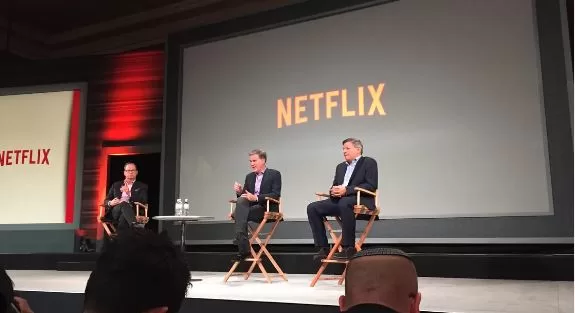
Netflix marketing strategy assists in achieving company’s corporate mission of seeking to drive conversation around Netflix content to further enhance member joy. In 2022 The streaming service spent in total to USD 2,53 billion or 8% of total revenues for marketing.[1] Netflix marketing strategy is based on the following principles: – Guerrilla marketing. Guerrilla marketing refers to an advertisement strategy where a company uses unusual methods to draw attention of the public to the brand. The most notable cases of guerrilla marketing by the largest streaming service in the world include a hand crawling by itself in the streets of New York to promote Wednesday show, “Strange Mode” car sharing ride with Lyft and installing doll from Squid Game show in Sydney Harbour. – High level of service personalization. The entertainment services provider suggests personalized content to its users on the basis of the past viewed content. The on-demand media provider suggests personalized content in its platform, as well as, thorough emails to maintain the high level of customer retention. – Meme marketing. Netflix effectively uses social media marketing in general and meme marketing in particular to increase the level of brand awareness in the global scale. One can be forgiven for mistaking Netflix social media pages for pages for meme. – Remaining focused. Netflix only offers movies, series and documentaries. The platform does not offer news and live sports. By remaining focused on movies, series and documentaries alone, the company avoids overextension of brand image and continues to increase the value it provides to its core audience. Netflix Inc. Report contains the above analysis of Netflix marketing strategy. The report illustrates the application of the major analytical strategic frameworks in business studies such as SWOT, PESTEL, Porter’s Five Forces, Value Chain analysis, Ansoff Matrix and McKinsey 7S…

PESTEL is a strategic analytical tool and the acronym stands for political, economic, social, technological, environmental and legal factors. Netflix PESTEL analysis involves the analysis of potential impact of these factors on the bottom line and long-term growth prospects of the popular streaming platform. Political Factors in Netflix PESTEL Analysis There are many political factors that can affect the financial performance of on-demand streaming services such as Netflix. These factors include government stability, trade union activities, bureaucracy and government tariffs. Moreover, corruption, trade controls and the freedom of press also belong to the list of political factors with a potentially significant impact on entertainment services providers. Leaving a market because of war Netflix was indirectly affected by Vladimir Putin’s invasion of Ukraine. Having entered Russian market in 2016, the largest streaming service in the world announced on March 6, 2022 the suspension of its services, projects and acquisitions in the country. Leaving the country within 10 days after Putin declared war in Ukraine was an act of solidarity with Ukraine and other global brands suspending their operations in Russia. At the same time, Netflix had no other choice, because had the company remained in Russia its brand image would have suffered significantly with negative implications on the stock price. Government restrictions Apart from Russia, China is the only country where Netflix is not available. Although they dress it otherwise, the Chinese government has banned the popular streaming platform because they don’t want their citizens to be influenced by western culture. In other words, Chinese authorities fear that a wide range of shows and programs available on Netflix may influence the population and they might become more difficult to control. Taking into account the massive size of Chinese market, not being allowed to operate in the market is…

SWOT is an acronym for strengths, weaknesses, opportunities and threats for organizations of all types. The following table illustrates Netflix SWOT analysis: Strengths 1. First mover advantage 2. Corporate culture 3. Original content 4. Global presence Weaknesses 1. Dependence of business model on other companies 2. High level of indebtedness 3. Over-dependence on North American home market 4. Compromised customer service Opportunities 1. Forming strategic partnerships 2. Product line extension 3. Benefiting from AI 4. Increasing focus on locally adapted content Threats 1. Failure of new co-CEOs 2. Video piracy 3. Loss of customers due to rising prices 4. Global market saturation Netflix SWOT Analysis Strengths in Netflix SWOT Analysis 1. Although Netflix did not invent on-demand video streaming, it has proved that this business model can be viable. Netflix was the first company to scale video streaming globally and the company name has become synonym for subsection based on-demand media with huge content library. First mover advantage is a considerable strength for Netflix because it increases brand recognition considerably and establishes the company’s serves as industry standards. 2. Netflix is famous for its non-orthodox corporate culture. The entertainment services provider encourages decision-making by employees at all levels and shares information openly, broadly and deliberately. Moreover, internal communications at the largest streaming service in the world are candid and direct and this also relates to employee performance feedback. Sophisticated corporate culture established by co-founder and former long-term CEO Reed Hastings has played an integral role in the success of the company and it is one of the formidable strengths associated with the business. 3. Netflix was among the first streaming platforms to produce its own content starting from 2011. Over the years the entertainment services provider was able to produce critically acclaimed shows worldwide such as House…
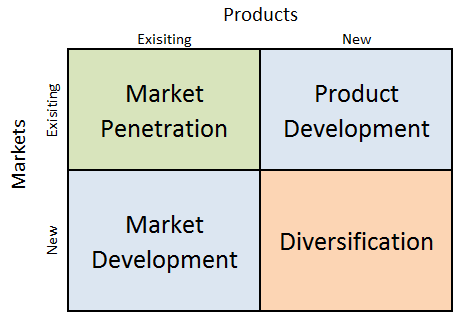
Netflix Ansoff Matrix is a marketing planning model that helps the largest streaming service in the world to determine its product and market strategy. Ansoff Matrix illustrates four different strategy options available for the on-demand media provider. These options are market penetration, product development, market development and diversification. Ansoff Growth Matrix Within the scope of Ansoff Matrix, Netflix uses all four growth strategies in an integrated way: 1. Market penetration. Market penetration refers to selling existing products to existing markets. Netflix engages in market penetration through an effective marketing strategy. The entertainment services provider targets outward-looking, affluent consumers with international credit cards and smartphones and uses anticipatory and mono-segment positioning to appeal to the needs and preferences of this segment. 2. Product development. This strategy involves developing new products to sell to existing markets. Product development is one of the main growth strategies for Netflix. The company is focused on producing original content. Furthermore, the streaming service is developing a growing number of non-English language originals from places such as Mexico, France, Italy, Japan and Brazil, to name just a few. 3. Market development. Market development strategy is associated with finding new markets for existing products. The on-demand media provider uses market development growth strategy extensively since its inception in 1998. Thanks to the successful implantation of this strategy, today Netflix is available virtually everywhere except in China and Russia and it has 231 million paid memberships in over 190 countries. [1] 4. Diversification. Diversification involves developing new products to sell to new markets and this is considered to be the riskiest strategy. The largest streaming service in the world uses diversification growth strategy rarely. Entering into gaming sector in 2021 is the only notable business diversification case for Netflix. Netflix Inc. Report contains the above analysis of Netflix Ansoff…
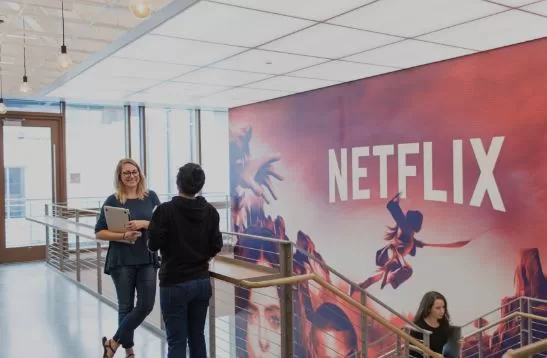
Netflix organizational culture integrates the following five key elements: 1. Encouraging decision-making by employees. The entertainment services provider encourages employees at all levels to take initiative and resolve issues on their own with minimum input from their superiors. Decision making at the on-demand media provider is made by individuals, referred to informed captains, rather than by teams or committees. Informed captains are experts in their area who listen to the viewpoints of other people and then make decisions on their own. Thanks to this principle Netflix doesn’t have to wait for consensus or vote by the committee and this is huge advantage taking into account highly dynamic nature of the external environment. 2. Sharing information openly, broadly and deliberately. Netflix has taken a radical approach towards information sharing. The largest streaming service in the world maintains online memos in narrative form for members of board of directors that not only include links to supporting analysis but also allow open access to all data and information on the company’s internal shared systems. This is unprecedented for a global corporation. Unlike, some other tech companies such as Apple, employees at all levels of the streaming service have access to all internal information. Access to data helps Netflix employees to make more informed decision making. Moreover, thanks to the access to information employees feel trusted and become more responsible at their job. 3. Communicating candidly and directly. Openness in communication is one of the pillars of Netflix organizational culture. Candid and direct communication also relates employee performance feedback. Openness has been ingrained into the culture of Netflix to such a degree that not speaking up one’s mind can be easily perceived as an act of disloyalty. 4. Keeping only our highly effective people. The streaming service models itself on being a…
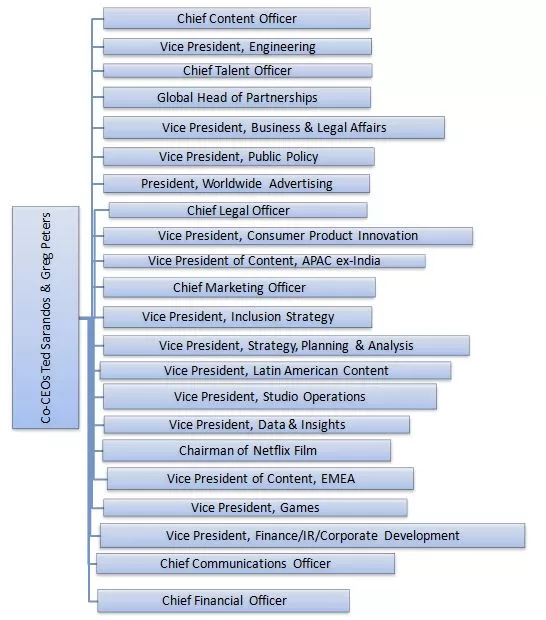
Netflix organizational structure can be classified as relatively flat. This is an unconventional for a multinational giant that employs more than 12500 people in offices in over 25 countries[1]. Fewer management layers increases the span of control for each manager. Corporate structure of Netflix can also be described as unitary or u-form. In companies with unitary structure the business is managed as a single unit and it has functional lines such as sales, marketing, engineering etc. Flat and unitary aspects of corporate culture of Netflix offers a range of advantages for the the entertainment services provider. Specifically, less hierarchy ensures faster and better communication among employees at all levels, thus increasing the speed and quality of decision making. This is critically important taking into account increasingly dynamic nature of the external marketplace and the need for the company to adapt quickly. Netflix organizational structure had to change early in 2023 when co-founder Reed Hastings stepped down from the role of CEO. Nevertheless, the flat and unitary nature of the organizational structure has remained. Moreover, even though Reed Hastings is no longer CEO of the on-demand media provider, he remains as the ultimate decision maker on the strategic issues. This arrangement may prove to be practically helpful whenever there is a disagreement between current co-CEOs Ted Sarandos and Greg Peters. Netflix Organizational Structure Netflix Inc. Report contains the above analysis of Netflix organizational structure. The report illustrates the application of the major analytical strategic frameworks in business studies such as SWOT, PESTEL, Porter’s Five Forces, Value Chain analysis, Ansoff Matrix and McKinsey 7S Model on Netflix. Moreover, the report contains analyses of Netflix leadership, business strategy and organizational culture. The report also comprises discussions of Netflix marketing strategy, ecosystem and addresses issues of corporate social responsibility. [1] ESG Report (2022)…
